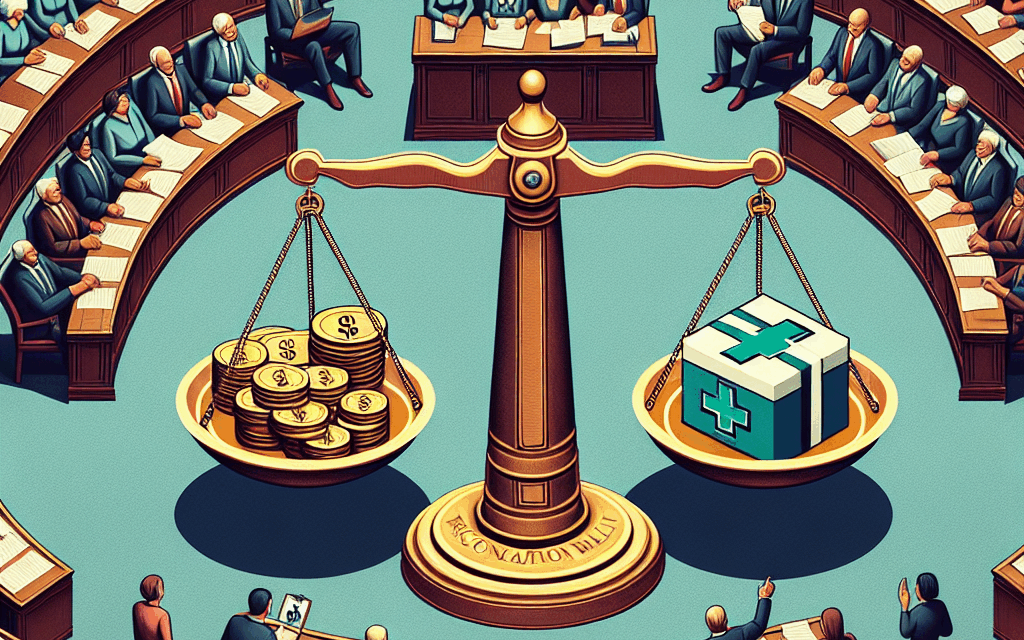House Approves Reconciliation Bill Featuring Significant Medicaid Reductions
The recent approval of a reconciliation bill by the House of Representatives has sparked intense debate across the political spectrum. This legislation, which includes significant reductions to Medicaid funding, has far-reaching implications for millions of Americans who rely on this vital program for their healthcare needs. In this article, we will explore the details of the bill, the implications of Medicaid reductions, the political landscape surrounding the legislation, and the potential impact on vulnerable populations. We will also examine case studies and statistics to provide a comprehensive understanding of this critical issue.
Understanding the Reconciliation Bill
The reconciliation bill, a legislative tool used to expedite the passage of budget-related legislation, was approved by the House with a narrow margin. This bill is part of a broader effort by the current administration to address fiscal challenges while attempting to reshape the healthcare landscape in the United States. The key components of the bill include:
- Significant cuts to Medicaid funding
- Changes to eligibility requirements
- Increased state flexibility in managing Medicaid programs
- Provisions aimed at reducing the federal deficit
- Potential impacts on other social safety net programs
The bill’s approval has raised concerns among healthcare advocates, state officials, and the general public about the potential consequences of these Medicaid reductions. Understanding the intricacies of the bill is essential for grasping its implications for healthcare access and quality in the United States.
The Implications of Medicaid Reductions
Medicaid is a critical program that provides health coverage to low-income individuals and families, including children, pregnant women, elderly individuals, and people with disabilities. The proposed reductions in Medicaid funding could have several implications:
1. Access to Healthcare Services
One of the most immediate concerns regarding Medicaid reductions is the potential loss of access to healthcare services for millions of Americans. With funding cuts, states may be forced to limit the services they provide or reduce the number of individuals eligible for coverage. This could lead to:
- Longer wait times for medical appointments
- Increased out-of-pocket costs for patients
- Reduced availability of specialists and essential services
For example, a study by the Kaiser Family Foundation found that states that implemented Medicaid cuts saw a significant increase in emergency room visits, indicating that patients were unable to access primary care services. This trend could exacerbate health disparities, particularly among marginalized communities who already face barriers to care.
2. Impact on State Budgets
States play a crucial role in administering Medicaid programs, and funding reductions could strain state budgets. Many states rely on federal matching funds to support their Medicaid programs, and cuts could lead to:
- Increased state spending to cover the shortfall
- Potential layoffs of healthcare workers
- Reduced funding for other essential services, such as education and public safety
For instance, a report from the National Association of State Budget Officers indicated that states facing Medicaid funding cuts had to make difficult decisions about budget allocations, often prioritizing healthcare over other critical services. This could lead to a domino effect, impacting various sectors of the economy and public welfare.
3. Health Outcomes and Public Health
Reducing Medicaid funding could have dire consequences for public health outcomes. Access to preventive care, mental health services, and chronic disease management is crucial for maintaining a healthy population. The potential impacts include:
- Increased rates of preventable diseases
- Higher mortality rates among vulnerable populations
- Strain on public health systems
A study published in the American Journal of Public Health found that states that expanded Medicaid under the Affordable Care Act saw significant improvements in health outcomes, including reduced mortality rates and increased access to preventive services. Conversely, states that cut Medicaid funding experienced worsening health indicators, highlighting the critical role of Medicaid in promoting public health.
4. Effects on Vulnerable Populations
The most vulnerable populations, including low-income families, the elderly, and individuals with disabilities, are likely to be disproportionately affected by Medicaid reductions. These groups often rely heavily on Medicaid for essential services, and cuts could lead to:
- Increased financial strain on families
- Loss of critical support services
- Higher rates of institutionalization for individuals with disabilities
For example, a case study from a state that implemented Medicaid cuts revealed that many families were forced to choose between basic necessities and healthcare. This not only affected their physical health but also their mental well-being, as the stress of financial insecurity took a toll on family dynamics.
5. Long-term Economic Consequences
The long-term economic consequences of Medicaid reductions could be profound. Healthcare is a significant driver of job creation and economic stability. Potential impacts include:
- Job losses in the healthcare sector
- Increased healthcare costs for individuals and families
- Negative effects on local economies reliant on healthcare services
A report from the Economic Policy Institute highlighted that cuts to Medicaid could lead to job losses in both healthcare and related industries, further exacerbating economic challenges in communities already struggling with high unemployment rates. The ripple effects of these cuts could hinder economic recovery efforts in the wake of the COVID-19 pandemic.
The Political Landscape Surrounding the Bill
The passage of the reconciliation bill has been met with fierce opposition and support from various political factions. Understanding the political landscape is crucial for grasping the motivations behind the bill and its potential future.
1. Bipartisan Divisions
The reconciliation bill has highlighted deep divisions between Democrats and Republicans regarding healthcare policy. While Democrats argue that the bill is necessary for fiscal responsibility and state flexibility, Republicans contend that it undermines essential healthcare access for vulnerable populations. Key points of contention include:
- Disagreements over the role of government in healthcare
- Concerns about the impact on low-income families
- Debates over the effectiveness of Medicaid as a safety net
These divisions have led to heated debates in Congress, with both sides mobilizing their bases to advocate for or against the bill. The political ramifications of these debates could shape future healthcare legislation and influence upcoming elections.
2. Advocacy and Opposition
Healthcare advocacy groups have been vocal in their opposition to the Medicaid reductions proposed in the reconciliation bill. Organizations such as the American Medical Association and the National Association of Medicaid Directors have expressed concerns about the potential consequences of funding cuts. Key arguments from advocates include:
- The importance of maintaining access to healthcare for low-income individuals
- The need for comprehensive healthcare reform rather than cuts
- The potential for increased healthcare costs in the long run
In response, proponents of the bill argue that reducing Medicaid funding is necessary to address the national deficit and promote state autonomy in managing healthcare programs. This ongoing debate underscores the complexity of healthcare policy in the United States.
3. The Role of State Governments
State governments play a crucial role in implementing Medicaid programs, and the proposed reductions could lead to significant changes in how states manage their healthcare systems. Some states may choose to:
- Implement stricter eligibility requirements
- Reduce benefits or services offered
- Explore alternative funding sources to mitigate cuts
For example, states like Texas and Florida have historically opted for more restrictive Medicaid policies, which could serve as a model for other states facing budget constraints. However, this approach raises concerns about the potential impact on healthcare access and outcomes for residents.
4. Public Opinion and Voter Sentiment
Public opinion plays a significant role in shaping healthcare policy, and recent polls indicate that many Americans are concerned about potential Medicaid cuts. Key findings from surveys include:
- A majority of voters support maintaining or expanding Medicaid coverage
- Concerns about the impact of cuts on vulnerable populations
- Desire for comprehensive healthcare reform rather than piecemeal cuts
As lawmakers navigate the political landscape, public sentiment could influence their decisions and shape the future of healthcare policy in the United States.
5. Future Implications for Healthcare Policy
The approval of the reconciliation bill could set a precedent for future healthcare policy decisions. As lawmakers grapple with budget constraints and competing priorities, the potential for further Medicaid reductions looms large. Key considerations for the future include:
- The need for sustainable healthcare funding models
- Opportunities for bipartisan collaboration on healthcare reform
- The importance of addressing social determinants of health
Ultimately, the political landscape surrounding Medicaid reductions will continue to evolve, and stakeholders must remain vigilant in advocating for policies that prioritize healthcare access and equity.
Case Studies and Statistics
To better understand the implications of Medicaid reductions, it is essential to examine case studies and statistics that illustrate the potential impact on individuals and communities. These examples provide valuable insights into the real-world consequences of policy decisions.
1. Case Study: Medicaid Expansion in Kentucky
Kentucky’s decision to expand Medicaid under the Affordable Care Act serves as a compelling case study. Following the expansion, the state experienced significant improvements in health outcomes, including:
- A 25% reduction in uninsured rates
- Increased access to preventive services
- Improved mental health outcomes among low-income individuals
However, recent discussions about potential Medicaid cuts have raised concerns about reversing these gains. Advocates argue that any reductions could lead to a resurgence of uninsured individuals and a decline in overall health outcomes.
2. Statistics on Medicaid and Health Disparities
Statistics reveal the critical role of Medicaid in addressing health disparities among marginalized populations. For example:
- Medicaid covers over 70 million Americans, including 40% of all children
- Studies show that Medicaid expansion has led to a 20% decrease in mortality rates among low-income individuals
- Access to Medicaid is associated with improved health outcomes for individuals with chronic conditions
These statistics underscore the importance of maintaining robust Medicaid funding to ensure equitable access to healthcare services for all Americans.
3. Case Study: Impact of Medicaid Cuts in Texas
Texas, which has not expanded Medicaid, provides a stark example of the consequences of funding cuts. Following budget reductions, the state saw:
- A significant increase in uninsured rates
- Higher emergency room visits due to lack of access to primary care
- Strain on local healthcare systems and providers
This case study highlights the potential dangers of Medicaid reductions and the importance of comprehensive healthcare access for vulnerable populations.
4. National Trends in Medicaid Enrollment
National trends in Medicaid enrollment reveal the program’s critical role in providing coverage during economic downturns. For instance:
- During the COVID-19 pandemic, Medicaid enrollment increased by over 10 million individuals
- States that expanded Medicaid saw higher enrollment rates compared to those that did not
- Medicaid serves as a safety net during economic crises, helping to stabilize families and communities
These trends emphasize the importance of maintaining robust Medicaid funding to support individuals during challenging times.
5. The Economic Impact of Medicaid Funding
The economic impact of Medicaid funding extends beyond healthcare access. Research indicates that:
- Every dollar spent on Medicaid generates approximately $1.50 in economic activity
- Medicaid funding supports millions of jobs in the healthcare sector
- Reductions in Medicaid funding could lead to significant job losses and economic instability
These findings highlight the interconnectedness of healthcare funding and economic stability, underscoring the need for thoughtful policy decisions that prioritize both health and economic outcomes.
Conclusion: The Path Forward
The approval of the reconciliation bill featuring significant Medicaid reductions marks a pivotal moment in U.S. healthcare policy. As lawmakers navigate the complexities of budget constraints and competing priorities, it is essential to consider the potential consequences of these decisions on vulnerable populations and public health outcomes.
Key takeaways from this analysis include:
- The importance of maintaining access to healthcare services for low-income individuals and families
- The potential economic ramifications of Medicaid funding cuts on state budgets and local economies
- The need for continued advocacy and public engagement to shape healthcare policy
- The critical role of Medicaid in addressing health disparities and promoting public health
- The necessity of exploring sustainable funding models for healthcare in the United States
As the political landscape continues to evolve, stakeholders must remain vigilant in advocating for policies that prioritize healthcare access, equity, and sustainability. The future of Medicaid and healthcare in the United States hangs in the balance, and it is imperative that we work collectively to ensure that all Americans have access to the care they need.





